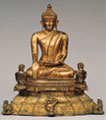 |
|
 |
 |
 |
 |
 |
 |
 |
 |
Sculpture from Burma (Myanmar)
The art and history of Buddhism in Burma (Myanmar) is datable to about the 1st century C.E., although there is only fragmentary material available from then until the emergence of the royal city of Pagan in the 11th century. While a number of different types of Buddhism were practiced in Burma, Theravada Buddhism was established as the dominant religion in 1056 by King Anawrahta (reigned 1044-1077) of Pagan, who unified the country. However, the several streams of Buddhist traditions that reached Burma left indelible traces upon its material culture as evidenced by the two Burmese images of the Buddha Shakyamuni in the Asia Society's collection; one can be linked to Mahayana Buddhism as indicated by the depiction of bodhisattvas flanking Shakyamuni, while the other can be connected to Theravada Buddhism by the presence of two of Shakyamuni's most important disciples shown kneeling before him. Although Hindu images dating from the 6th to the 10th century have been found, Hinduism never established itself firmly in Burma. |
 |
 |
| 1 thru 2 of 2 |
 |
| view text only list |
 |

Seated Buddha |
 |

Buddha Shakyamuni |
 |
|
 |